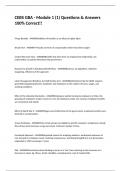CEBS GBA - Module 1 (1) Questions & Answers
100% Correct!!
Fringe Benefits - ANSWERAddition of benefits as an offset to higher labor
Broad View - ANSWER"Virtually any form of compensation other than direct wages"
Limited (Narrow) View - ANSWERBenefits that stem from an employment relationship, not
underwritten or paid for directly by the government
Reasons for growth in Employee Benefit Plans - ANSWERBusiness, tax legislation, collective
bargaining, efficiency of the approach
Labor Management Relations Act (Taft Hartley Act) - ANSWERAdministered by the NLRB, requires
good faith bargaining between employers and employees in the matters of hours, wages, and
working conditions.
Effect of the Industrial Revolution - ANSWEREmployees started moving to employers in Cities, the
grouping of employees made it easier to cover all employees under one contract. Employer benefits
are convenient and simple.
Effect of World War II - ANSWERWages were limited due to the government, employee benefits were
deemed as compensation.
Group Technique - ANSWEROnly certain groups are eligible (a specific company's employees), steady
flow of lives (cost increases as age increases), minimum number of lives.
Functional Approach - ANSWEROrganized system for analyzing audience, participants exposure to
risk, focused on employee needs, reducing company loss, and being thoughtful of cost parameters,
originated in 1967 by George C. Foust.
Risk - ANSWERUncertainty when thinking in terms of a 'loss' (Loss referring to the insurance of a
decrease in value). Eg. Illness, death, disability, unemployment, cost of medical bills .
, Peril - ANSWERThe cause of personal/property loss, destruction, or damage.
Hazard - ANSWERA condition that increases the probability of a peril occurring or that can increase
the loss in the event of a peril.
Physical Hazard - ANSWERThe presence of flammable materials in absence of extinguishers,
machines without safety mechanisms, faulty heating/air conditioner units.
Moral Hazard - ANSWERDishonest, unethical, and immoral people - those who steal/damage
company property; file fraudulent medical claims, abuse sick time, falsify pay records or expenses
Legal Liability Risk - ANSWERA loss resulting from negligent acts of a person resulting in injury to
another person. Stems from an injured plaintiff seeking damages.
Personal risk - ANSWERThe type of risk that is the focal point of employee benefit plans?
Morale Hazard - ANSWERThose that arise through a person acting careless. It can also include the act
of not securing items of value; failing to notify employees of hazards, etc.
Pure Risk - ANSWEREither risk will happen, or will not happen. These types of risks can be insured.
Eg. sickness, accident, unemployment, disability, theft of property, etc.
Speculative Risk - ANSWEREither loss, no loss, or gain. Eg. Purchases of stock, new business ventures,
gambling. In each, one could lose, break even, or gain.
Personal Risk - ANSWERThe most important risk in employee benefits. Includes death, illness,
accidents, unemployment, and old age. Can be measured with some degree of accuracy. Potential
loss can be estimated through estimates of such factors as medical costs.
Property Risk - ANSWERRisk of uncertainty that leads to decrease in value of real personal property.
Includes fire, flood, earthquake, wind, theft, auto collision. Types of property include home,
furniture, cars, jewelry.




